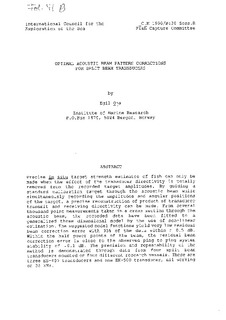| dc.contributor.author | Ona, Egil | |
| dc.date.accessioned | 2012-08-21T14:29:23Z | |
| dc.date.available | 2012-08-21T14:29:23Z | |
| dc.date.issued | 1990 | |
| dc.identifier.citation | This report is not to be cited without prior reference to the author | no_NO |
| dc.identifier.uri | http://hdl.handle.net/11250/104697 | |
| dc.description.abstract | Precise in situ target strength estimates of fish can only be
made when the effect of the transducer directivity is totally
removed from the recorded target amplitudes. By guiding a
standard calibration target through the acoustic beam while
simultaneously recording the amplitudes and angular positions
of the target, a precise reconstruction of product of transducer
transmit and receiving directivity can be made. From several
thousand point measurements taken in a cross section through the
acoustic beam, the recorded data have been fitted to a
generalized three dimensional model by the use of non-linear
estimation. The suggested model functions yield very low residual
beam correction error with 95% of the data within ± 0. 5 dB.
Within the half power points of the beam, the residual beam
correction error is close to the observed ping to ping system
stability of ± 0.1 dB. The precision and repeatability of the
method is demonstrated through data from four split beam
transducers mounted on four different research vessels. These are
three ES-400 transducers and one EK-500 transducer, all working
on 38 kHz. | no_NO |
| dc.language.iso | eng | no_NO |
| dc.publisher | ICES | no_NO |
| dc.relation.ispartofseries | ICES CM Documents;1990/B:30 | |
| dc.subject | acoustics | no_NO |
| dc.subject | akustikk | no_NO |
| dc.title | Optimal acoustic beam pattern corrections for split beam transducers | no_NO |
| dc.type | Working paper | no_NO |
| dc.subject.nsi | VDP::Agriculture and fishery disciplines: 900::Fisheries science: 920::Fisheries technology: 924 | no_NO |
| dc.source.pagenumber | 12 s. | no_NO |
